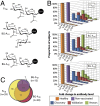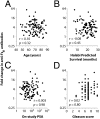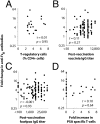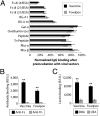Humoral response to a viral glycan correlates with survival on PROSTVAC-VF
- PMID: 24733910
- PMCID: PMC4035954
- DOI: 10.1073/pnas.1314722111
Humoral response to a viral glycan correlates with survival on PROSTVAC-VF
Erratum in
-
Correction for Campbell et al., Humoral response to a viral glycan correlates with survival on PROSTVAC-VF.Proc Natl Acad Sci U S A. 2015 Jun 30;112(26):E3451. doi: 10.1073/pnas.1510832112. Epub 2015 Jun 9. Proc Natl Acad Sci U S A. 2015. PMID: 26060311 Free PMC article. No abstract available.
Abstract
Therapeutic cancer vaccines can be effective for treating patients, but clinical responses vary considerably from patient to patient. Early indicators of a favorable response are crucial for making individualized treatment decisions and advancing vaccine design, but no validated biomarkers are currently available. In this study, we used glycan microarrays to profile antiglycan antibody responses induced by PROSTVAC-VF, a poxvirus-based cancer vaccine currently in phase III clinical trials. Although the vaccine is designed to induce T-cell responses to prostate-specific antigen, we demonstrate that this vaccine also induces humoral responses to a carbohydrate on the poxvirus, the Forssman disaccharide (GalNAcα1-3GalNAcβ). These responses had a statistically significant correlation with overall survival in two independent sample sets (P = 0.015 and 0.008) comprising more than 100 patients. Additionally, anti-Forssman humoral responses correlated with clinical outcome in a separate study of PROSTVAC-VF combined with a radiopharmaceutical (Quadramet). Studies on control subjects demonstrated that the survival correlation was specific to the vaccine. The results provide evidence that antiglycan antibody responses may serve as early biomarkers of a favorable response to PROSTVAC-VF and offer unique insights for improving vaccine design.
Keywords: Forssman antigen; glycan array.
Conflict of interest statement
Conflict of interest statement: C.T.C., J.L.G., O.O., J.S., and J.C.G. are co-inventors on a patent application covering the new biomarker reported in this manuscript. PROSTVAC-VF is being developed under a Cooperative Research and Development Agreement between Bovarian Nordic and the Center for Cancer Research.
Figures







Similar articles
-
Serum antibodies to blood group A predict survival on PROSTVAC-VF.Clin Cancer Res. 2013 Mar 1;19(5):1290-9. doi: 10.1158/1078-0432.CCR-12-2478. Epub 2013 Jan 29. Clin Cancer Res. 2013. PMID: 23362327 Free PMC article.
-
Prostvac-VF: a vector-based vaccine targeting PSA in prostate cancer.Expert Opin Investig Drugs. 2009 Jul;18(7):1001-11. doi: 10.1517/13543780902997928. Expert Opin Investig Drugs. 2009. PMID: 19548854 Free PMC article. Review.
-
Overall survival analysis of a phase II randomized controlled trial of a Poxviral-based PSA-targeted immunotherapy in metastatic castration-resistant prostate cancer.J Clin Oncol. 2010 Mar 1;28(7):1099-105. doi: 10.1200/JCO.2009.25.0597. Epub 2010 Jan 25. J Clin Oncol. 2010. PMID: 20100959 Free PMC article. Clinical Trial.
-
Prospects and limitations of recombinant poxviruses for prostate cancer immunotherapy.Curr Opin Mol Ther. 1999 Aug;1(4):471-9. Curr Opin Mol Ther. 1999. PMID: 11713762 Review.
-
ABO blood type correlates with survival on prostate cancer vaccine therapy.Oncotarget. 2015 Oct 13;6(31):32244-56. doi: 10.18632/oncotarget.4993. Oncotarget. 2015. PMID: 26338967 Free PMC article.
Cited by
-
Whole-Cell Cancer Vaccines Induce Large Antibody Responses to Carbohydrates and Glycoproteins.Cell Chem Biol. 2016 Dec 22;23(12):1515-1525. doi: 10.1016/j.chembiol.2016.10.012. Epub 2016 Nov 23. Cell Chem Biol. 2016. PMID: 27889407 Free PMC article.
-
Unique repertoire of anti-carbohydrate antibodies in individual human serum.Sci Rep. 2020 Sep 22;10(1):15436. doi: 10.1038/s41598-020-71967-y. Sci Rep. 2020. PMID: 32963315 Free PMC article.
-
Multiplex Glycan Bead Array (MGBA ) for High Throughput and High Content Analyses of Glycan-Binding Proteins Including Natural Anti-Glycan Antibodies.Methods Mol Biol. 2022;2460:33-44. doi: 10.1007/978-1-0716-2148-6_3. Methods Mol Biol. 2022. PMID: 34972929 Free PMC article.
-
Multiplex glycan bead array for high throughput and high content analyses of glycan binding proteins.Nat Commun. 2018 Jan 17;9(1):258. doi: 10.1038/s41467-017-02747-y. Nat Commun. 2018. PMID: 29343722 Free PMC article.
-
Profiling natural serum antibodies of non-human primates with a carbohydrate antigen microarray.Xenotransplantation. 2020 Mar;27(2):e12567. doi: 10.1111/xen.12567. Epub 2019 Nov 24. Xenotransplantation. 2020. PMID: 31762117 Free PMC article.
References
-
- Kantoff PW, et al. IMPACT Study Investigators Sipuleucel-T immunotherapy for castration-resistant prostate cancer. N Engl J Med. 2010;363(5):411–422. - PubMed
-
- Wolchok JD, et al. Guidelines for the evaluation of immune therapy activity in solid tumors: Immune-related response criteria. Clin Cancer Res. 2009;15(23):7412–7420. - PubMed
-
- Cipriani B. Immunological markers of cancer vaccine efficacy and their clinical relevance. Biomarkers Med. 2009;3(3):253–264. - PubMed
Publication types
MeSH terms
Substances
Grants and funding
LinkOut - more resources
Full Text Sources
Other Literature Sources
Medical

